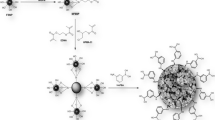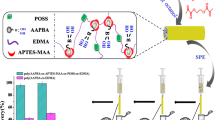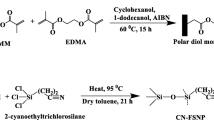Abstract
Non-specific protein adsorption on hydrophobic solid phase extraction (SPE) adsorbents can reduce the efficacy of purification. To improve sample clean-up, poly(divinyl benzene) (PDVB) monoliths grafted with hydrophilic polyethylene glycol methacrylate (PEGMA) were developed. Residual vinyl groups (RVGs) of the PDVB were employed as anchor points for PEGMA grafting. Two PEGMA monomers, M n 360 and 950, were compared for graft solutions containing 5–20% monomer. Protein binding was qualitatively screened using fluorescently labeled human serum albumin (HSA) to determine optimal PEGMA concentration. The fluorescent signal of PDVB was reduced for PDVB-g-PEGMA360 (10%) and PDVB-g-PEGMA950 (20%). The PEGMA content (w/w%) was quantified by solid state 1H NMR to be 29.9 ± 1.6% for PDVB-g-PEGMA360 and 7.7 ± 1.2% for PDVB-g-PEGMA950. To assess adsorbent performance breakthrough curves for PDVB, PDVB-g-PEGMA360 and PDVB-g-PEGMA950 were compared. The breakthrough volume (V B) and shape of the curve for PDVB-g-PEGMA950 were maintained relative to PDVB (2.3 and 2.8 mL, respectively). A reduced V B of 0.5 mL and shallow breakthrough curve indicated PDVB-g-PEGMA360 was not suitable for SPE. A high ibuprofen recovery of 92 ± 0.30 and 78 ± 0.93% was seen for PDVB and PDVB-g-PEGMA950, respectively. Protein adsorption was reduced from 31 ± 2.41 to 12 ± 0.49% for PDVB and PDVB-g-PEGMA950, respectively. SPE of ibuprofen from plasma was compared for PDVB and PDVB-g-PEGMA950 by at-line electrospray ionization mass spectrometry (ESI-MS). PDVB-g-PEGMA950 demonstrated a threefold increase in assay sensitivity indicating a superior analyte purification.








Similar content being viewed by others
References
Westerlund D. Direct injection of plasma into column liquid chromatographic systems. Chromatographia. 1987;24:155–64.
Annesley TM. Ion suppression in mass spectrometry. Clin Chem. 2003;49:1041–4.
Chen Y, Guo Z, Wang X, Qiu C. Sample preparation. J Chromatogr A. 2008;1184:191–219.
Li Y, Lee ML. Biocompatible polymeric monoliths for protein and peptide separations. J Sep Sci. 2009;32:3369–78.
Georgi K, Boos KS. Multidimensional on-line SPE for undisturbed LC-MS-MS analysis of basic drugs in biofluids. LC GC Eur. 2004;17:21–4.
Cassiano NM, Lima VV, Oliveira RV, de Pietro AC, Cass QB. Development of restricted-access media supports and their application to the direct analysis of biological fluid samples via high-performance liquid chromatography. Anal Bioanal Chem. 2006;384:1462–9.
Souverain S, Rudaz S, Veuthey J-L. Restricted access materials and large particle supports for on-line sample preparation: an attractive approach for biological fluids analysis. J Chromatogr B. 2004;801:141–56.
Hagestam IH, Pinkerton TC. Internal surface reversed-phase silica supports for liquid chromatography. Anal Chem. 1985;57:1757–63.
Cook SE, Pinkerton TC. Characterization of internal surface reversed-phase silica supports for liquid chromatography. J Chromatogr A. 1986;368:233–48.
Turson M, Zhou M, Jiang P, Dong X. Monolithic poly(ethylhexyl methacrylate-co-ethylene dimethacrylate) column with restricted access layers prepared via reversible addition-fragmentation chain transfer polymerization. J Sep Sci. 2011;34:127–34.
Candish E, Wirth H-J, Gooley AA, Shellie RA, Hilder EF. Characterization of large surface area polymer monoliths and their utility for rapid, selective solid phase extraction for improved sample clean up. J Chromatogr A. 2015;1410:9–18.
Yang H, Ulbricht M. Synthesis and performance of PP microfiltration membranes grafted with polymer layers of different structure. Macromol Mater Eng. 2008;293:419–27.
Gisch DJ, Hunter BT, Feibush B. Shielded hydrophobic phase: a new concept for direct injection analysis of biological fluids by high-performance liquid chromatography. J Chromatogr B. 1988;433:264–8.
Kanda T, Shirota O, Ohtsu Y, Yamaguchi M. Synthesis and characterization of polymer-coated mixed functional stationary phases with several different hydrophobic groups for direct analysis of biological samples by liquid chromatography. J Chromatogr A. 1996;722:115–21.
Buchmeiser MR. Polymeric monolithic materials: syntheses, properties, functionalization and applications. Polymer. 2007;48:2187–98.
Smirnov KN, Dyatchkov IA, Telnov MV, Pirogov AV, Shpigun OA. Effect of monomer mixture composition on structure and chromatographic properties of poly(divinylbenzene-co-ethylvinylbenzene-co-2-hydroxyethyl methacrylate) monolithic rod columns for separation of small molecules. J Chromatogr A. 2011;1218:5010–9.
Gu B, Armenta JM, Lee ML. Preparation and evaluation of poly (polyethylene glycol methyl ether acrylate-co-polyethylene glycol diacrylate) monolith for protein analysis. J Chromatogr A. 2005;1079:382–91.
Krenkova J, Lacher NA, Svec F. Highly efficient enzyme reactors containing trypsin and endoproteinase LysC immobilized on porous polymer monolith coupled to MS suitable for analysis of antibodies. Anal Chem. 2009;81:2004–12.
Barlow KJ, Hao X, Hughes TC, Hutt OE, Polyzos A, Turner KA, et al. Porous, functional, poly (styrene-co-divinylbenzene) monoliths by RAFT polymerization. Polym Chem. 2014;5:722–32.
Peters EC, Svec F, Fréchet JMJ, Viklund C, Irgum K. Control of porous properties and surface chemistry in “molded” porous polymer monoliths prepared by polymerization in the presence of TEMPO. Macromolecules. 1999;32:6377–9.
Hubbard KL, Finch JA, Darling GD. Epoxidation of the pendant vinylbenzene groups of commercial poly (divinylbenzene-co-ethylvinylbenzene). React Funct Polym. 1999;42:279–89.
Tripp JA, Needham TP, Ripp EM, Konzman BG, Homnick PJ. A continuous-flow electrophile scavenger prepared by a simple grafting procedure. React Funct Polym. 2010;70:414–8.
Gaborieau M, Nebhani L, Graf R, Barner L, Barner-Kowollik C. Accessing quantitative degrees of functionalization on solid substrates via solid-state NMR spectroscopy. Macromolecules. 2010;43:3868–75.
Claridge TDW (2009) High-resolution NMR techniques in organic chemistry, Second Edition.
Morcombe CR, Zilm KW. Chemical shift referencing in MAS solid state NMR. J Magn Reson. 2003;162:479–86.
Sýkora D, Peters EC, Svec F. “Molded” porous polymer monoliths: a novel format for capillary gas chromatography stationary phases. Macromol Mater Eng. 2000;275:42–7.
Candish E, Gooley A, Wirth H-J, Dawes PA, Shellie RA, Hilder EF. A simplified approach to direct SPE‐MS. J Sep Sci. 2012;35:2399–406.
Jarmalavičienė R, Kornyšova O, Westerlund D, Maruška A. Non-particulate (continuous bed or monolithic) restricted-access reversed-phase media for sample clean-up and separation by capillary-format liquid chromatography. Anal Bioanal Chem. 2003;377:902–8.
Jarmalavičienė R, Kornyšova O, Bendokas V, Westerlund D, Buszewski B, Maruška A. Restricted-access media development for direct analysis of drugs in biofluids using capillary liquid chromatography. Anal Bioanal Chem. 2008;391:2323–8.
D’Sa RA, Meenan BJ. Chemical grafting of poly (ethylene glycol) methyl ether methacrylate onto polymer surfaces by atmospheric pressure plasma processing. Langmuir. 2010;26:1894–903.
Mangiante G, Alcouffe P, Burdin B, Gaborieau M, Zeno E, Petit-Conil M, et al. Green nondegrading approach to alkyne-functionalized cellulose fibers and biohybrids thereof: synthesis and mapping of the derivatization. Biomacromolecules. 2013;14:254–63.
Bielicka-Daszkiewicz K, Voelkel A. Theoretical and experimental methods of determination of the breakthrough volume of SPE sorbents. Talanta. 2009;80:614–21.
Acknowledgements
RAS is the recipient of an Australian Research Council Australian Research Fellowship (DP110104923). EC is the recipient of an Australian Postgraduate Award. Support from the University of Tasmania Central Science Laboratory is gratefully acknowledged. We gratefully acknowledge Dr. Karsten Gömann and Dr. Sandrin Feig (University of Tasmania) for assistance with scanning electron microscopy and Patrice Castignolles (University of Western Sydney) for helpful discussions.
Author information
Authors and Affiliations
Corresponding author
Ethics declarations
Conflict of interest
The authors declare that they have no conflict of interest
Ethics approval
This study was approved by the Tasmanian Health and Medical Human Research Ethics Committee (protocol H0010488), Australia. Following this protocol, blood samples were obtained from participants with informed consent.
Electronic supplementary material
Below is the link to the electronic supplementary material.
ESM 1
(PDF 5304 kb)
Rights and permissions
About this article
Cite this article
Candish, E., Khodabandeh, A., Gaborieau, M. et al. Poly(ethylene glycol) functionalization of monolithic poly(divinyl benzene) for improved miniaturized solid phase extraction of protein-rich samples. Anal Bioanal Chem 409, 2189–2199 (2017). https://doi.org/10.1007/s00216-016-0164-y
Received:
Revised:
Accepted:
Published:
Issue Date:
DOI: https://doi.org/10.1007/s00216-016-0164-y




